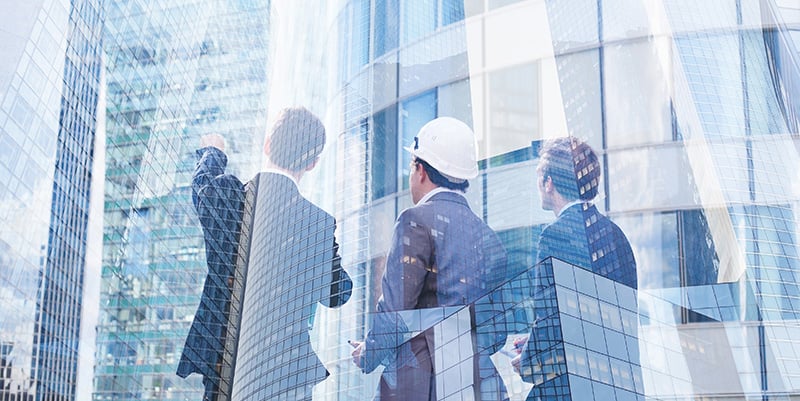
As an energy retrofit professional, you don’t need anybody to tell you about conventional energy retrofits.
But these are unconventional times when it comes to the demand for more energy efficiency, especially for commercial and industrial buildings. That’s because, as Energystar.gov reports, those buildings are responsible for half of the nation’s energy use and nearly half of its greenhouse gas emissions. The U.S. Department of Energy estimates that on average, 30% of the energy used in commercial buildings is wasted due to inefficiencies.
So, it’s no surprise that deep energy retrofits are an increasingly popular topic of discussion among building owners and managers. But that’s just the tip of the iceberg.
What Is a Deep Energy Retrofit? And Why Now?
While conventional energy retrofits tackle a single system at a time, deep energy retrofits do so on a larger and more integrated scope. They are likely to include improvements in the building’s envelope, like adding insulation and better windows, ensuring air tightness, and evaluating the interactions between all the different energy-related components in a building.
There are plenty of reasons why there is such momentum for commercial buildings and industrial plants to initiate deep energy retrofits to decrease energy demand.
Government Policy – Federal buildings are taking the lead with the White House's Climate Smart Buildings Initiative. The National Deep Energy Retrofit program works with ESCOs to modernize federal buildings to reduce site energy consumption through deep energy retrofits.
Energy Cost Savings – Aside from the obvious benefits to the bottom line, when a business frees up funds that were previously committed to energy costs, that creates opportunities to fund additional energy-saving projects like solar upgraded equipment, or investing for growth over the long term.
Energy and Environmental Regulations – The national movement that is powering sustainability policy is only gaining steam, and commercial and industrial buildings are a top focus. Within those buildings, lighting and HVAC are the biggest energy consumers.
Corporate Social Responsibility – Employee engagement and productivity, customer loyalty, and brand reputation are all positively impacted by a company’s commitment to pursuing responsible environmental, social, and economic (or governance) strategies.
One thing all these reasons have in common? They will become even more widespread and urgent as time goes on. Polishing up your knowledge and skills to capture more energy retrofit business is a smart strategy for your company.
The Key to Deep Energy Retrofit Success? Collaboration.
It would be easy to assume that a deep energy retrofit involves reducing a building’s current energy consumption by 50% or more.
While that is correct (and certainly desirable!), the reality goes much deeper than that.
We spoke with Timothy Unruh, the Executive Director of The National Association of Energy Service Companies (NAESCO), who revealed the importance of the working relationships between Energy Service Companies (ESCOs)/contractors and building owners.
“One thing that defines a deep energy retrofit is the fact that the contractor and the owner collaborate by sharing the risk and looking for all the ways to push the envelope in what they install. That relationship allows the project scope to go beyond what it might have otherwise.”

- Timothy Unruh, Executive Director, NAESCO
As Unruh says, the good news is that the ESCO model is perfectly suited for these relationships:
"Everything about the ESCO process is collaborative. The owner selects a contractor without a scope in mind, then they work together to develop a scope and collaboratively reach agreement on how the systems and equipment will be operated, because they will be operated in conjunction for many years after that.”
When an ESCO is working under an energy performance contract (EPC), which provides the customer with a guaranteed level of energy savings, the upfront collaboration on scope becomes all the more important, as is setting targets that are realistic given the building’s capacity for energy savings and the owner’s willingness to implement change.
Says Unruh:
“A very efficient building might only have a 25% savings opportunity. To even get to 20% of that, you would probably need to be pretty innovative in the energy tech installed. A wasteful building might offer an opportunity to save 90% of the energy, but if you’re only delivering 60%, you probably didn't do a very “deep” deep energy retrofit or only scoped the “low-hanging fruit.”
How to Maximize Client Savings With Deep Energy Retrofits
To ensure a deep energy retrofit generates the maximum possible energy savings, the project will also require that building management and occupants take a proactive role in energy conservation. After all, you can install the most advanced and sophisticated control system and the most efficient equipment possible in a building, but if it's operated improperly, it can consume more energy than what it is replacing.
As the energy retrofit professional, you need to look at all the ways to squeeze energy use out of a building. That may include suggesting changes that you’ll have to talk through with the owner or manager to get agreement.
“One idea might be an advanced shutdown and setback of the building controls. If everybody goes home at 5 p.m., I can shut the HVAC off at 4 and the building can coast for an hour. The owner may say that everybody comes in at 8 a.m., but as operators, we know that in reality people stagger in between 8 and 9. I can run the HVAC system on a limited basis during that hour and save some additional energy before kicking into schedule mode,” recommends Unruh.
You’re the one with the expertise, and sometimes you’ll have to be a salesperson to explain the benefits to get the buy-in you need from the owner or operator.
A Greener Future Means More Green for Your Company
For a long time, businesses thought making their operations greener would sink their profitability. But now, we’re realizing that sustainability is just that: A way for businesses to benefit today while still building a better future for future generations. It’s that triple bottom line we can all aim for: people, planet, and profit.
The green industrial revolution is in full swing, and as businesses increasingly look to slash their energy usage and become more sustainable, they’ll be looking to companies like yours to help them find the best approach. By forging a collaborative partnership for the long term, you can secure maximum savings for your clients and a sustainable future for your business.
For a deeper dive into your own retrofit growth prospects and optimizing your operation with the best digital execution platform, click the button below and book a tour with one of our SnapCount specialists. They’ll help you prepare your business for exponential growth.





Share this post: